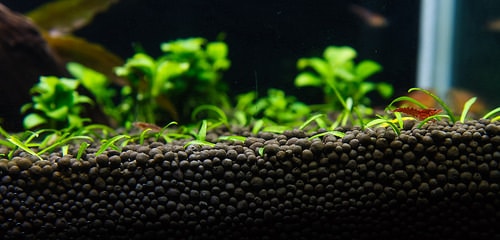
Table of Contents
What are Substrates?
Substrates are an essential component to any aquarium.
A substrate is simply a fancy way of referring to something that is beneath something else.
In the plant, and specifically aquatic world, this layer is also the location of biological processes.
That is to say, living things grow here and we want to make sure we create the most hospitable environment for plants and beneficial bacteria to thrive in.
The two most common types of aquarium substrate used today are complete and compound.
While they sound similar, they are actually very different.
Complete substrate is named complete for a reason: it is ready to go out of the box. This type of substrate can be added to your aquarium and is immediately ready to grow plants and bacteria on.
Compound substrate requires a little more work on the front end, a process known as capping.
Let’s look at the importance of aquarium substrates and how to choose the right one for you and your aquarium.
Substrates as Growth Medium
Substrates are extremely important for a multitude of reasons.
One of their most important functions is serving as a breeding ground for beneficial bacteria.
These bacteria are responsible for breaking down waste products from both fish and plants, as well as recycling uneaten fish food into beneficial chemicals.
An aquarium substrate can be deemed successful if it serves as an efficient biological agent in a given aquarium scenario.
The most efficient substrates produce a water system that is high in nutrients and a healthy environment for fish and underwater plants.
These beneficial bacteria also assist the ecosystem by preventing the accumulation of harmful chemicals.
Different Substrate Solutions for Different Aquariums
Complete substrate solutions come in many different arrangements, for a variety of aquarium sizes and a multitude of price points, guaranteed to fit into any budget.
Some complete substrate solutions are designed to be poured into the aquarium bed and have plants attach to it right away.
Ammonia spikes are common since an early influx will facilitate bacterial colonization sooner.
This portion of the aquarium cycle should be done before any fish are added, since it would be a harmful environment to subject fish or plants to.
Once the filter is matured by this process fish and plants can be added without any concern for their safety.
When added to a suitable base layer (such as volcanic pumice), it can function as a biological filter.
The complete system will serve as an efficient filter and promote water movement, ensuring it stays as fresh as possible.
Compound Substrates
Compound substrates are very different from complete substrate solutions.
Typically, the compound substrate is poured into the bottom of the aquarium, sometimes with gradient leading towards the front of the enclosure (mostly for aesthetic purposes).
The capping sequence entails covering the substrate with a thin layer of lime free gravel which keeps the substrate from making the water system murky.
A good rule of thumb would be no less than three centimeters and no more than five centimeters. The higher concentration near the rear of the tank will provide ample space for plants.
What about Gravel?
Though decorative gravels are substrates, only using gravel is not a recommended solution.
Its usefulness as a capping compound as well as an aesthetic component demonstrates how this natural approach is something to be strived for.
Naturally occurring bodies of water experience this same phenomenon.
The motion of water deposits materials in river beds, much like a substrate in an aquarium.
Materials are naturally spread based on their size and weight.
This naturally occurring scenario is recreated using the substrate and capping procedure mentioned previously.
Routine Maintenance is Key
Regardless of what substrate solution you decide on, do not forget about the routine maintenance necessary to the continued efficiency of the aquarium.
In this case, the name of the game is being gentle.
A gentle weekly vacuuming should deter particle build up.
Rake the sand gently to keep it from collecting debris.
Follow these simple recommendations and you will be enjoying your aquarium for years to come!
